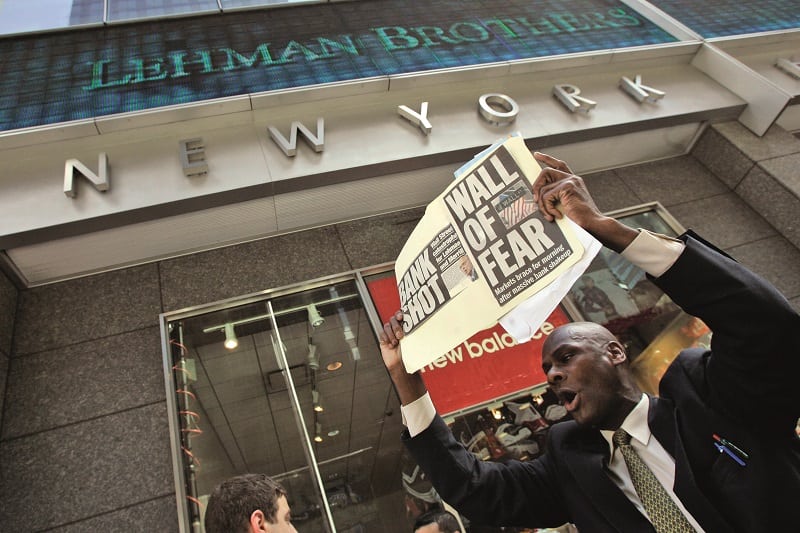It may be a case of pick your event when it comes to dating the exact 10-year anniversary of the financial crisis. Lehman Brothers’ collapse which happened 10 years ago on 15 September is most people’s favourite. Following Lehmans, the US fully embraced the idea of ‘too big to fail’ when it came to global insurer AIG and, for that matter, most of the investment banks on Wall Street and mortgage specialists across the US.
Others would make the case for Bear Stearns’ fire sale to JP Morgan in March or even the freezing of three BNP Paribas hedge funds focused on sub-prime loan investments and derivatives – something which occurred 11 years ago in August 2007.
In the UK, Northern Rock’s entire deposit book was guaranteed by the government on 17 September 2008 following a bank run. Subsequently, two UK high street banks and many smaller institutions required variously bailouts, breakups, nationalisations and forced marriages. Something that would have been almost unthinkable at the start of the decade, was the fact that the casualty list eventually included RBS and a merged Lloyds TSB and HBoS.
In Europe, the UK and Ireland were initially the hardest hit, but same story pretty much applied across western Europe.
To sum up the impact on markets by the end of 2008, the FTSE 100 had its worst even year down 31.3%. The Dow Jones had lost 34%, its worst since 1931. A recession and a eurozone crisis were to follow.
One could argue that the rest is history, except for the fact that the repercussions of the crisis and subsequent ‘great recession’ are still being felt.
In the run up to the main anniversaries, Portfolio Adviser asked fund groups and advisers to think about the reasons for the crisis and consider whether we are safe from another.
Hidden leverage in financial markets
Adrian Hull, co-head of fixed income at Kames Capital, says: “Financial markets lost one thing in 2008. Confidence. And we now understand what drained confidence from markets; excessive leverage. Of course, we also know that Lehman was more highly leveraged than was sustainable but what was opaque was the hidden leverage what we now call “shadow banking” – and it was the implosion of liquidity from capital withdrawal in “shadow banking” that did for Northern Rock.
“In short order the ripple effect meant there were no buyers for Northern Rock’s mortgage-backed securities leading to a poorly handled Bank of England rescue, and the regulatory framework proved insufficient to deal with the maelstrom. We understand this and the bailout that followed.”
The impact of austerity
Alistair Cunningham, financial planning director at Wingate Financial Planning, adds: “We cannot really ever know what happened, nor the effect of intervention as we cannot demonstrate the counter-factual. For example, there’s a significant school of thought that suggests austerity was the wrong action.”
Richard Potts, CEO and CIO at IM Wealth Management, says multiple books and articles, culminating recently in Adam Tooze’s Crashed, have documented and explained to an extent what happened.
However, he adds: “While we are aware of the events that coincided with the crisis and the proximate cause – Lehman’s bankruptcy – we still have an incomplete understanding of all the interacting economic, political and corporate events that combined to bring about the Lehman’s demise.
“With many discredited economic policies continuing to be practiced by many governments throughout the world, a complete understanding remains elusive and probably will always be so. That though is very different from a sufficient understanding to prevent such a set of circumstances from reoccurring.
Potts says for the time being we are safe from a repetition of housing related, special purpose vehicles, leveraged CMOs and the like. For one thing, banks are financially much stronger and regulation, for the time being, much tougher. But, he asks, are we safe from other threats? Almost certainly not.
“We live in a complex world with a multitude of dynamic forces interacting in ways that are not fully appreciated let alone understood. Boom-bust cycles of one sort or another have characterised modern economic history and there is little reason to assume that this will change anytime soon. What we do have is the ability to actively manage our investments in a cost-efficient manner moving between asset classes as the underlying dynamics change.”
Cunningham questions whether, in Europe particularly, the problem been resolved given there is still a risk of a significant financial shock if, for example, a bank failed. Italy looks particularly precarious and is one of the largest economies in Europe after Britain and Germany.
He says: “The biggest issue now is that while things may look healthier, and financial institutions may appear more resilient, the truth is we have far fewer tools in the arsenal should things go wrong again.
“It tends to be the unexpected events that catch us out, and therefore the obvious threats – protectionism, Brexit etc. could well be red herrings.”
What have investors learned?
Hull says central banks and regulators are now far more alive to lending markets than 10 years ago leading us to feel safer.
“Investors, of course, are a little more circumspect and baulk at negative interest rates and excessive PEs,” he adds. “Investors are aware of what a change in confidence in current central banking practice might mean as the ‘everything bubble’ challenges. It is, however, the overlooked and ignored that was the touch paper for the confidence crash in the last crisis and so too will it be in the next.”
Potts remains unsure whether individual investors have learned much.
He adds: “While it might sound cynical, individual investors have probably not learned much. Example of investors rushing into assets, stocks or currencies just as they reach the exponential phase of their move continue to abound, look at bitcoin as an example. It’s probably all part of the human psyche with behavioural economics providing multiple reasons why this happens.
“One would hope governments would have learned something, especially as they ignored the lessons of the Great Depression in the 1930. As JK Galbraith clearly showed in his book covering that time, not allowing banks to go under and to pursue a counter-cyclical fiscal policy to offset weakening economic growth are requirements to prevent a cyclical downturn turning into a structural depression. As we saw, and in too many cases continue to see, these lessons haven’t been learned by many governments.”
Chris Lean, Aisa International director, adds: “Retail investors are interested in returns from the markets and interest rates on savings. Just prior to the financial crisis taking hold in 2008, interest rates were 5% with inflation reaching similar levels. Now interest rates are 0.75%, with inflation at 2.5% so peoples’ deposit based savings are not keeping up with inflation. The FTSE has increased by about 35% over this period in what has been a prolonged bull market.
“Many think the markets are very high at the moment and there is no doubt there will be a correction at some point. Should traditionally risk averse investors start moving from deposit-based investments and start investing in the markets to get better returns?
“With personal debt levels in the UK in excess of £1.5trn, being just over £30,000 for each UK resident (about 115% of average earnings), the relatively easy availability of cheap money means is not difficult to see what could happen if interest rates are raised should inflation start to increase.
“We are already seeing house prices falling in London and if debts start rising faster than incomes and interest rates increase, then one wonders what investors have learned over the past 10 years.”









